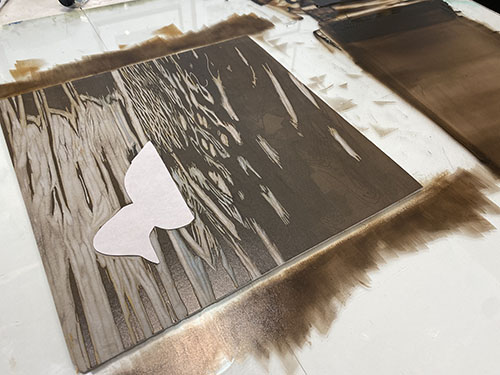Part of why I decided to tackle the current linocut in progress was that it gave me an opportunity to work with a different and unexpected color palette. Spoiler alert: This image is mostly ochres and browns.
But one of the most important elements of the image IS the blue one might expect from reflections on a bird on water. However, I've already got significant amounts of yellow ochre on the paper. I considered doing the blue patch immediately after the lightest yellow... from a get-the-color-right-and-give-it-some-luminosity standpoint it would have been the correct decision. But even when I cut a mask to try to contain the very distinct shapes, this blue is going to affect everything that goes on top of it. By cutting away and printing a second yellow before this step, I narrowed down the size of that affect.
It's hard to explain... so let me show you how it went.
First... I cut a mask.
Or, more precisely, I cut a stack of masks. In a perfect world I would have made even smaller, more precise shapes... but it's just too difficult (read: impossible) to hand cut more than a dozen identical masks out of newsprint. Maybe if I had some sort of machine to cut them. But, no. I have me, and I have an Xacto knife.
Masks cut, it was time to mix the blue. It needs to be fairly opaque to cover the ochre that's already here, but I don't want to add so much white it looks chalky. Careful. Careful.
 |
| Step 4 rollup |
You can see several color attempts at the upper edge of my work surface here. I knew the yellow underneath would darken this blue, so I made it as light as I dared without going chalky. Here it is masked on the press.
And printed.
 |
| Step 4 printed |
Meh. I didn't love it. It looks quite dark, and a little bit gray... which was expected. I decided to go ahead and put this color on all the prints anyway, and resigned myself to a second blue run over the top of this one that would hopefully push things the direction I wanted.
I tried this:
Test blue for Step 5
Which brightened the blue but made it too dark. I am pretty sure I went ahead and printed this on all the prints, although I don't seem to have taken a photo. It's too dark, but it's very transparent and it will add some more "influencing" color to the blue that ultimately goes on top.
Because of course I mixed and tested a couple more blues and eventually settled on this. More white added than I wanted. Chalkier color. But not much else to be done. I had already sent a couple of prints to the reject "tester" pile.
 |
| Step 6 ink rollup |
I think you can see that I took advantage of having a sub-optimal blue already on the prints by carving a few little areas that would allow the "wrong" blue to still be present. Why not? A little more color variety never hurt anything.
Same mask shape applied:
 |
| Step 6 mask |
And the resulting prints:
 |
| Step 6 printed |
It wasn't perfect, but it was time to move on. There were several more darker layers to go around these blue shapes, so I just hoped additional darker values would visually brighten things up.
Whew. That was a lot of work to get a little color on less than a third of the entire image. Let's hope the rest of this is a little more straightforward!
(Spoiler alert #2: It wasn't. Not particularly, anyway.)























































